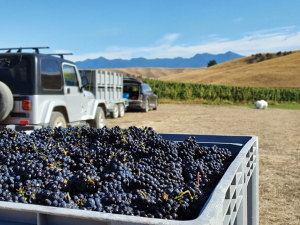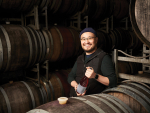In 2003, The Times’ Jane MacQuitty told her readers, “Tuck into Central Otago Pinot Noir, at last Burgundy has a serious New World rival.” It was a thrilling endorsement for a variety which only five years prior had snuck past Cabernet Sauvignon to become New Zealand’s most planted red variety, albeit at a modest 596 hectares. By 2003 this had mushroomed to 2,624ha, and today New Zealand ranks fourth globally, with 5,613ha of Pinot Noir vineyards, and wines that continue to earn global acclaim.
The country’s rapid ascent in quality and reputation is driven by inherently suitable growing conditions, improved viticultural practices, and refined winemaking techniques. However, it’s not all plain sailing. Plantings and exports have stagnated, domestic consumption is declining in line with global trends, and rising production costs are adding further pressure.
Pioneers set the vision
New Zealand’s Pinot Noir history dates back to the late 1880s, with early plantings in Hawke’s Bay and Wairarapa. The modern era began in the late 1970s and early 1980s, with tiny outposts in West Auckland, Canterbury, Wairarapa and Central Otago. Nobilo’s 1976 Huapai Pinot Noir became one of the first widely recognised quality examples, and Babich’s 1981 Henderson Pinot Noir won the first Pinot Noir gold medal at the New Zealand Easter Show. Danny Schuster’s 1982 St Helena Canterbury Pinot Noir was a seminal wine, with writer Bob Campbell MW claiming that it did for Pinot Noir what Te Mata Coleraine did for Bordeaux blends, providing “a beacon for others to follow”.
The early pioneers of Martinborough, in particular, established a high-quality bar and drove technical collaboration with initiatives such as the Pinot Workshop, and a celebration that culminated in 2001’s first international Pinot Conference in Wellington. Inspired by these successes, plantings increased, with a notable southward trend due to the variety’s preference for cooler regions. Today, Wairarapa south dominates production, with Central Otago alone accounting for nearly 30% of the country’s Pinot plantings, despite having just 5% of its vineyards.
As vines have aged, the interplay between site and clone has also become clearer. There are now many more single vineyard wines, although it is too early to tell if they are genuinely superior or simply different. Of course, the former can’t be established if the latter aren’t pursued, and great wine should always be based upon something tangible rather than created solely by ambitious winemaking or marketing. Indeed, this slow shift from ambition via winemaking to one more focused on greater transmission of site is an extremely important one – after all, a variety can be grown anywhere but place is forever unique.
New Zealand Pinot’s evolution has not only been place-centric. The past decade in particular has seen a marked shift toward style diversity, with a burst of natural and ‘nouveau’ wines, plus the odd foray into blends. While generously fruited, silky wines remain a cornerstone, there is a growing emphasis on age-worthy styles. Jane Skilton MW wrote in her recent Inside Burgundy report on Central Otago: “Some wines were really quite reticent and needed time in the glass to show their character. In these wines tannins were impactful… this is an exciting change. New Zealand needs to cement its place as a producer of the very highest quality Pinot Noir, able to craft wines that create excitement and prompt global wine lovers to buy them and put them in their cellars.”
As established producers refine their approaches, generational change is shaping the industry. Younger winemakers and new entrants have brought fresh perspectives and energy, with an increasing focus on organic and biodynamic farming, natural wines, and experimental styles. With ever-higher capital cost barriers, many operate via side hustles and establish relationships with premium growers focused on providing fruit to numerous small players. There are also a number of wineries operating multi-producer, small batch production.
But despite the exciting raw material, committed producers and global reputation, New Zealand Pinot Noir faces headwinds. Plantings have stalled, increasing by just 100ha in the past decade. While it remains New Zealand’s top red export, in 2023 it was overtaken by Pinot Gris as the second most exported variety behind Sauvignon Blanc.
A global decline in wine consumption is mirrored in domestic figures and compounded by rising production costs and logistics challenges. There is no denying the financial pressures faced by producers, especially smaller ones. Geography makes us a largely artisanal place, and premium Pinot Noir production demands low yields. Maintaining and replanting aging vineyards, managing weather events, and investing in necessary infrastructure and sustainability initiatives all require significant resources.
Globally, New Zealand Pinot Noir is positioned on a double-edged sword: it offers consistency and quality but is at risk of being perceived as a safe, reliable choice rather than an exciting, interesting one. This is a barrier to increasing prices, and keeps our wine pigeonholed as mid-tier in the competitive global Pinot Noir quality hierarchy. The tiny volumes of the majority of the best wines mean few get to experience them, particularly those that transcend variety into something more. As Pen Naish of Black Estate observes: “If we don’t tell our story with excitement and authenticity we will be overlooked, and competition from other countries will be tough.”
The Path to Maturity
Progress is seldom linear and great Pinot Noir takes time. Within little more than a generation, we have established an impressive degree of quality and the potential for so much more. But being able to sustain and nurture both the underlying land and businesses so the next generation can pick up the torch and continue the hard work is vital. Laser focus on high quality is a more realistic path to this than dependency on volume.
At a recent tasting, Rippon’s Nick Mills quoted American novelist Wendell Berry’s statement, “Eating is an agricultural act” (and by extension an environmental and political one), which can logically be extended to wine, particularly given it’s a choice rather than necessity. At a personal level, individuals have a choice of who and what they support when purchasing wine, and the same is true at an industry level. A united vision of high quality, allied with environmental and social sustainability, will chart New Zealand on a course to great heights. There will inevitably be setbacks and growing pains. But with the successes achieved already, there are plenty of reasons to believe this is a direction that’s well within our grasp, should we so choose.
The View from Afar
Renowned Burgundy expert Jasper Morris MW offers a somewhat cautious view of the current state of New Zealand’s Pinot Noir. “Not a lot has really changed between the various visits I’ve had. Certainly, things are growing in competence – people have been doing things for longer, and the understanding is better, including of locations. But have there really been many new people entering the scene that are of interest? Not a lot.”
He asks where the new initiative, or new styles, lie. “You can’t keep saying the same story, as the unfortunate reality is this will not capture the world’s interest.” New Zealand is no longer seen as the “new kid on the block” in international markets and despite consumers recognising established names, there seems to be limited curiosity about exploring beyond them. Jasper observes that Covid-19 was a huge knock to New Zealand, exacerbating its distance and isolation, with inbound tourism and investment still struggling to recover. He argues that New Zealand’s best Pinot Noirs – “your gleaming icons” – are undervalued, and there’s a need to command higher prices, allowing the next tier to settle in below them at a more sustainable price in the long term. He foresees challenges doing this in the current global economic climate but, “the raw material is there, and some good people are doing good things”.
United States writer and former Pinot Noir New Zealand 2017 keynote speaker Elaine Chukan Brown is more optimistic, highlighting the category’s achievements and noting how quickly, “the best of New Zealand Pinot Noir sat among the best in the world”.
Elaine warns against relying on safe winemaking and is encouraged by the “small second wave of trailblazers” currently making strides by focusing on site distinction and excellence. “It is the standout producers pushing Pinot’s potential into new areas that gain recognition internationally and bring greater respect and acclaim.” This also depends on fostering good relationships with international trade and media as consumers discover wine through them.
The country’s geographical distance and small scale create challenges, but our ability to make Pinot Noir that delivers site transparency and distinctive quality will open the door for greater recognition, Elaine says. “The bright acidity, incredible aromatics and savoury depth possible there get me every time.”
London-based New Zealander and restaurateur Melanie Brown, former owner of specialist outlet The New Zealand
Cellar, feels frustrated by the decline in depth and distribution of New Zealand Pinot Noir available in the United Kingdom during the past 15 years, compared to the diversity she sees when back home. She thinks economic difficulties and waning alcohol consumption mean the market will remain an increasingly tough one for producers for some time.
Melanie says Central Otago remains the flagship region, overshadowing others, and laments the lack of education around regional and subregional differences in the UK. Despite this, New Zealand has done an “outstanding” job of making Pinot affordable and achievable to consumers there, she says. “A wine they can relate to and that packs a punch with personality and approachability. The commitment to quality means there is seldom a poor-quality example.”












